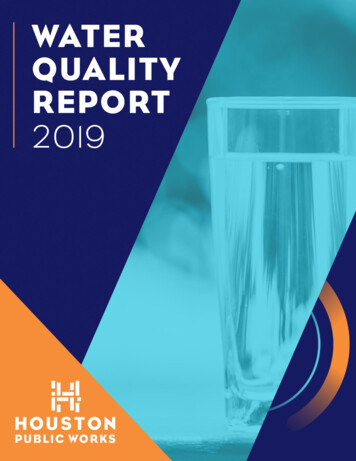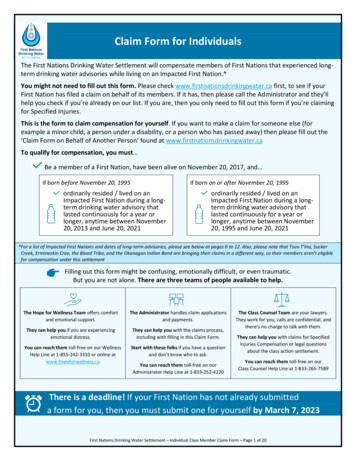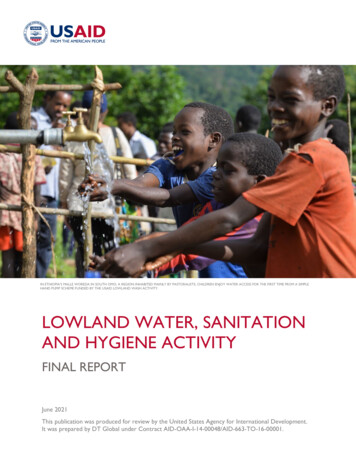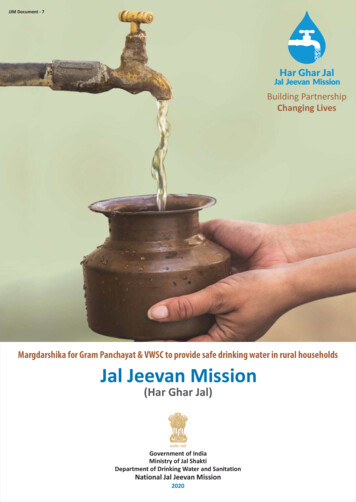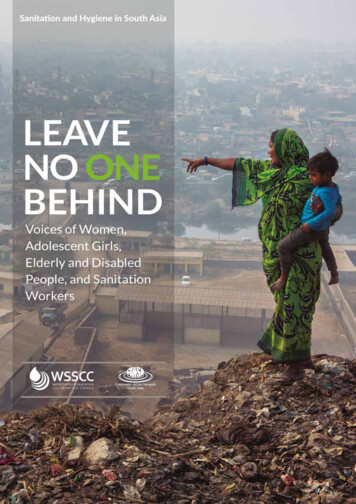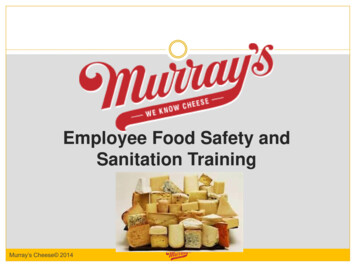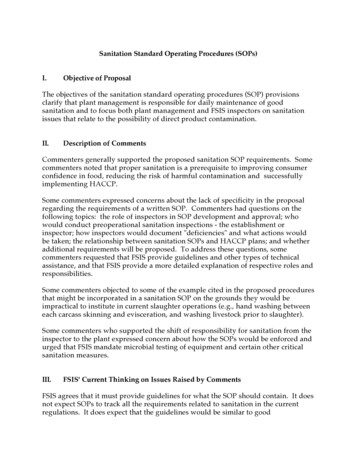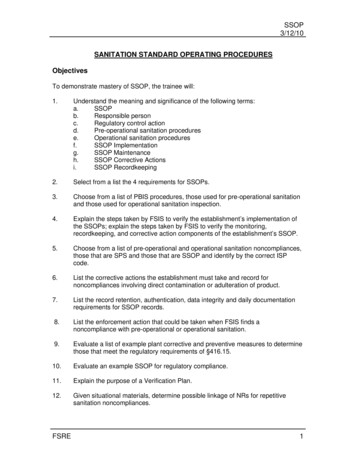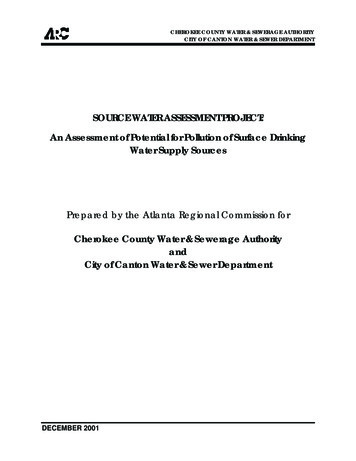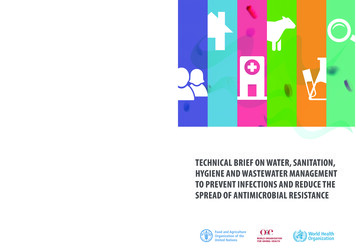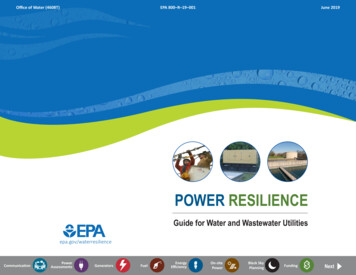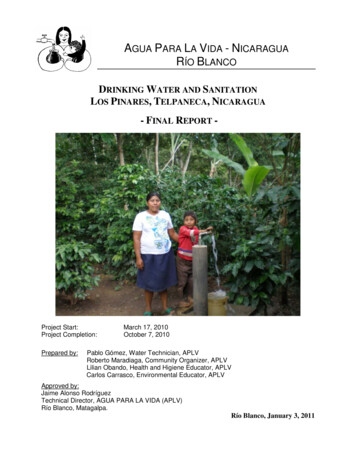
Transcription
AGUA PARA LA VIDA - NICARAGUARÍO BLANCODRINKING WATER AND SANITATIONLOS PINARES, TELPANECA, NICARAGUA- FINAL REPORT -Project Start:Project Completion:Prepared by:March 17, 2010October 7, 2010Pablo Gómez, Water Technician, APLVRoberto Maradiaga, Community Organizer, APLVLilian Obando, Health and Higiene Educator, APLVCarlos Carrasco, Environmental Educator, APLVApproved by:Jaime Alonso RodríguezTechnical Director, AGUA PARA LA VIDA (APLV)Río Blanco, Matagalpa.Río Blanco, January 3, 2011
TABLE OF CONTENTSLIST OF ABBREVIATIONS. 31-INTRODUCTION . 41.12-PROJECT BENEFICIARIES . 5EMPOWERMENT OF LOCAL CAPABILITIES . 52.1ACTIVITIES COMPLETED. 52.2RESULTS ACHIEVED . 62.2.1 Inter-institutional Agreements. 62.2.2 Working with the community . 62.2.3 Structure and Operation of CAPS . 72.2.3.12.2.42.2.52.2.62.2.6.12.2.6.23-LATRINE DESIGN . 18LATRINE CONSTRUCTION. 18RESULTS . 18HEALTH AND HYGIENE EDUCATION . 185.15.25.36-TECHNICAL SUMMARY . 13DESCRIPTION OF THE SYSTEM. 14WATER QUALITY . 17RESOLUTION OF TECHNICAL PROBLEMS ENCOUNTERED . 17RURAL SANITATION . 184.14.24.35-General Organization and Maintenance . 11Billing and financial control . 12GRAVITY DRINKING WATER SYSTEM . 133.13.23.33.44-CAPS Administratve training . 9CAPS Technical Training. 9Agreements . 11Future management of the water system . 11ACTIVITIES UNDERTAKEN . 18RESULTS ACHEIVED. 20ONGOING MONITORING . 21ENVIRONMENTAL PROGRAM. 216.1SUMMARY OF THE WATERSHED SITUATION . 216.2ACTIVITIES UNDERTAKEN . 226.2.1 Development of coordination between local participants . 226.2.2 Protection of the Spring and Developing Watershed Awareness . 226.3RESULTS ACHIEVED. 237-CONCLUSION . 237.17.27.3ACHIEVEMENT OF OBJECTIVES . 23LESSONS LEARNED. 23ACKNOWLEDGMENTS . 24
LIST OF ABBREVIATIONSAPLVC/UCRPQcmcfCAPSØDN qRDSCHSDRTPU/MNTUAgua Para La VidaCada Uno (Each)Caja Rompe Presión (Break Pressure Tank)Caudal (Flow)Centímetro (Centimeter)Coliformes fecales (fecal coliform)Comité de Agua Potable y Saneamiento (Water and sanitation committee)Diámetro (diameter)Diámetro Nominal (nominal diameter)grado (degree)Hierro Fundido (iron)Hierro Galvanizado (galvanized iron)Kilómetro (kilometer)Libra (pound)Línea de Conducción (conduction line)Litros por minute (liters per minute)Litros por Segundo (liters per second)Manantial (spring)Metro (meter)Metro cuadrado (square meter)Metro cúbico (cubic meter)Mililitro (milliliter)Mini-Acueducto por Gravedad (gravity flow system)Ministerio de Salud (Health Ministry)Ministerio de Educación (Education Ministry)No Aplicable (Not Applicable)Operación y Mantenimiento (Operation and Maintenance)Poli Cloruro de Vinilo (polyvinyl chloride)Quintal (100 pounds)Red de distribución (distribution system)Tubería de alta presión ( 175 m) (high pressure pipe)Tubería para presión ( 175 m) (normal pressure pipe)Tanque Propuesto (proposed tank)Unidad de Medida (unit of measurement)Unidades Nefelométricas de turbidez (Nephelometric turbidity units)
1 - INTRODUCTIONThis document is the final report for the drinking water and sanitation project in the community ofLos Pinares carried out by Agua Para La Vida from March 17, 2010 to October 7, 2010.The community of Los Pinares is located 17 kilometers from the Municipality of Telpaneca,Nicaragua and 218 kilometers from the capital Managua.This project was funded by the Rotary Club of Colorado, the Ann Campana Judge Foundation,the Laird Narton Family Foundation, the Telpaneca municipal government and the community ofthe Los Pinares.Agua Para La Vida, was responsible for financial management, project oversight andeducational programs.Situation before the projectAs with all Agua Para La Vida projects, the initial request for this Project was initiated from thecommunity. This ensures the need for the Project and the motivation of the community.Los Pinares is a disperse rural community of 60 families with a total population of 310inhabitants. Of the 60 families, 6 have only an empty lot in the community with the hope ofbuilding a house soon. There is also a church and a school.A portion of the population used a gravity-fed water system with 5 public faucets, and the restgot water from surface water or small hand-dug wells on their own properties.The existing gravity system, built with assistance from CARITAS in 1995, was designed and builtfor a population of only 12 families. The situation with the water supply was critical for familiesbecause the system did not meet the demand.In addition, the spring catchment was open and the pipes were in poor condition, resulting in 39fecal coliforms/100 ml of water. The tapstands were also in poor condition and their locationswere no longer relevant.In the community, 92% of households had no toilets or latrines were in poor condition, resultingin a high percentage of people defecating in the open.Regarding sanitation, the situation was worrying, the families were not in the habit of eliminatingwaste properly or keeping drinking water covered. In addition, families had domestic animalsrunning loose, contaminating the community.Please refer to the proposal for additional details on the characteristics of the community, thesituation before project implementation, and preliminary studies of the feasibility of the project.
1.1Project BeneficiariesWaterSix families dropped out of the project. Although they had signed individual work commitments,they would not get involved in project implementation. Six other families with lots but no housesdid contribute since, according to APLV standards, tapstands will be added when the houses arebuilt (the pipes already goes to their sites).Consequently 50 tapstands were built stations: 48 for houses, one for the church and one for theschool. Six additional tapstands await new houses.The 56 tapstands represent 285 direct beneficiaries. Since the system was designed for 15years with a growth rate of 3% annually, the projection of the number of beneficiaries isestimated to 445 beneficiaries in 15 years.SanitationForty-nine latrines were built: 48 for homes, plus one for the owner of the spring as part of theagreement (see part 2.2.6.a). These are the same beneficiaries who received water.2 - EMPOWERMENT OF LOCAL CAPABILITIESCommunity organization and development of local capabilities is a key part of any successfulcommunity project. This community organization depends on good preparation of the project, itsgood development, and finally the ability of future sustainability.As mentioned above, social work begins long before the start of physical implementation in orderto prepare the community for a successful project.2.1Activities CompletedDuring the project, the following activities were completed:PeriodNov 09 – Mar 10Nov 09 – Mar 10Nov 08 – Nov 09Nov 09 – Mar 10Nov 09 – Mar 10Activities- First contacts with the community, assessment of the need for theproject and the social feasibility- Presentation of APLV policies and acceptance of these policies by thecommunity- Election of the Water Supply and Sanitation Committee (CAPS)- Negotiations with the landowners of the spring and location of the tank- Negotiations to obtain easements for the pipeline- Signed agreements with MINSA, MINED and the municipalgovernment- Signed work agreements with each member of the communityand APLV- Creation of two groups to organize the work during the execution of theproject
Apr 10 - Sep 10Apr 10 - Sep 10May 10 - Oct 102.22.2.1- Agreements with the community to ensure the logistics of the project:staff housing and food, storage for materials- Informational meetings, project evaluation and critique- Administrative training for CAPS- Technical training for CAPSResults AchievedInter-institutional AgreementsAPLV executed agreements with the Ministry of Health (MINSA), Ministry of Education (MINED)and the Municipality of Telpaneca.The aim of the agreement with the MINSA was to create a link between it and the community,especially with the CAPS health promoters.This link has the long-term objective of providing CAPS members with support from MINSA inthe form of future training, water quality analysis, chlorine to disinfect the system, and benefitfrom campaign to eradicate rats, bedbugs and other pests.The agreement with the MINED allowed the APLV health promoters to intervene in schools togive talks and community meetings with families. It also enabled them to publicize their activitiesin health education to MINED and the Los Pinares school teacher so there can be follow-upactivities in the future.The agreement with the Telpaneca Mayor’s office stipulated that the municipality would providesignage, water meters, food, tools and materials for the inauguration. Unfortunately, thisagreement was not fulfilled except the donation of tools to start the project and the contributionof food for only two months.2.2.2Working with the communityWe have to mention that the community work was very difficult. The families were active at thebeginning of the project but after three months the involvement decreased significantly. Thecommunity did not support the APLV technician enough in the remaining activities. To resolvethis situation, community organizers generally motivated families with monthly evaluativemeetings. In addition, home visits were to families that were not motivated. By the end of theproject, each family contributed an average of 50 working days, a significant investment of timeand energy.
The food situation was alsodifficult for the staff of APLVbecause neither the communitynor the mayor responded withthis contribution. Severalmeetings were held to resolvethis problem, and foodcollections were made from eachfamily.Despite these issues, we hadvery good participation of womenin general in this project. Inparticular the promotersresponsible for Health andReforestation (see 2.2.3).Community Assembly, APLV PromotersMotivating the community: 'Working together'2.2.3Structure and Operation of CAPSThe preliminary phase allowed us to identify community leaders to form the CAPS.Then the implementation phase of the project allowed us to evaluate the operation of the CAPSand provide support as they began their work.CAPS did not have good involvement of all participants, mainly due to the personality of thecoordinator. The CAPS coordinator (also Assistant Mayor) is a person who was veryauthoritarian, did little listening to the other members of CAPS, and at the same time was notfully involvd in project development.APLV seeks to avoid mixing the water project management and political officials in order toavoid conflicts of interest but, as is easily understood, people who have responsibilities at themunicipal level are also the leaders of a community.To improve the involvement of CAPS,APLV staff proposed to the communitythat they re-elect the committee.The coordinator was relected to hispost by the community.Consequently, APLV favoredintegration of very active people duringthe execution of the project toreinforce the dynamics of thecommittee.Active participation of the women
For example, the current head of reforestation became involved with a lot of energy managingmaterials and reforestation activities, and was then made responsible for monitoring activities inthe area of the Environment.CAPS was structured as follows:RolePerson in chargePositionCoordinatorJosé de Jesús Polanco MateyVice MayorVice-CoordinatorGilberto López vargasFarmerSecretaryGilberto López vargasFarmerTreasurerAlberto Polanco CárdenasLoan officialHealthArcenia González MartínezProduction presidentReforestationGloria TalaveraProduction secretaryOperations and MaintenanceSeverino cárdenas Pérez.FarmerCommittees were formed in the areas of Health, Reforestation and Operation / Maintenance tosupport those responsible for carrying out the project activities and future activities: Health Commission: 3 inorder to make home visitsfor litter contro; Reforestation: 2 people toallow for sufficient follow-up; Operations andMaintainence: 3 people tocarry our meter reading andmaintenance.Community assembly, APLV Community organizer
2.2.3.1 CAPS Administrate trainingThe following administrative themes were taught to CAPS:PeriodNov 2009Nov 2009Apr2010May 2010Jun - Sep 2010ThemesCommunity organizingWhat is a leader?Work and function of the Drinking Water and Sanitation CommitteeAdministration and TarrifsDiscussion and adoption of rulesFor administrative training sessions, we achieved a 95% attendance, despite the difficulty ingathering members, and especially the coordinator, who showed little interest in these trainings.Community assembly with APLV community organizer2.2.4CAPS Technical TrainingThe following technical topics and skills were taught:PeriodNov 24, 2009Jun 3, 2010Jun 18, 2010Aug 27, 2010Sep 3, 2010Sep 21, 2010TheoryIdentification and diagnosis of problems in drinking water systems in ruralcommunities.Identifying types of diameters, schedules and PVC and iron pipe fittingsOperation of the spring, transmission line and its components.Methods to carry out flow measurement at the spring, tank and faucetsMethodology and precautions in handling the system.Maintenance, use, meter reading, and billing for water service payment perbeneficiary.
Technical Training, O&MPeriodNov 24, 2009Nov 25, 2009PracticePractice identifying diameter PVC and iron pipe fittingsPractice of diagnosis of the most common problems in water systems in ruralcommunities.May 13, 2010 Installation of system components and the spring capture and reducing thediameter of the pipeline.Jul 15, 2010 Installation of pipe in various diameters, reducing diameters, valve installationAug 17, 2010 Installation of bypass and gate valves.Sep 6, 2010 Flow measurement at the spring, tank and faucetsOct 7, 2010 Reading meters and filling out water monthly water bills.These trainings were conducted sothat CAPS members were able tosolve problems that might arise in thefuture. The participants showedinterest and gave importance to thesubjects taught with respect to theirsystem.The training 'maintenance, use andmeter reading' and ‘Monthly houseoldwater billling' were conducted withmembers of the Operation andMaintenance Committee, who areresponsible for these tasks.Practical training 'Installation of meters'APLV Technical Project Manager
These trainings can be a little hard todigest for community members withvery little education.To support these members andconsolidate the knowledge with moreconfidence in the meter reading andbilling, we asked two young men whoare currently studying 4th year highschool to participate in this training andto form a support group for these tasks.Water Billing Training, APLV Community Organizer2.2.5a)AgreementsSpringIn this project we used two sources of water.- The first spring is located on the property of Mr. Genaro López Polanco. The ownergave the water rights to the community in exchange for a tapstand. This agreement waslegalized through a notarized agreement.- The second spring is located on the property of Mr. Justo Gómez Matey. This owneralso gave the water rights to the community in exchange for a tapstand. In addition, hewas given a latrine to help prevent fecal contamination of the spring. This agreement wasalso legalized through a notarized agreement.b)TanqueThe land under the tank was donated by Mrs. Antonia Melgara Varela, owner of the plot,tin exchange for a reduction in work days to 15 days to get her tapstand.c)Easements for the pipelineLegal agreements were made for the passage of the pipeline from the spring to the tank.2.2.6Future management of the water system2.2.6.1 General Organization and MaintenanceCAPS was organized to ensure the ongoing the proper use, operation and maintenance of thewater system. CAPS is certified by the council and approved by the local authorities of themunicipality, which guarantee for order and compliance with articles that were established in theRules of Procedure of the community. The committee was trained and is responsible formaintaining the project. To enforce regulation, they can use the authorities if necessary, and willbe supported by them to implement sanctions. In this case we will request the support of Police,Mayor and Local Judge of the municipality.
The CAPS is responsible for fulfilling the following tasks to maintain the water system: Operate, monitor and manage the water system; Comply with the monitoring of the protected spring, preventing fires or deforestation inthe same area; Clean spring boxes, tanks and other places that require continuous monitoring; Perform preventive maintenance on the system; Read the meters each month and make the bills for water consumption of each family; Manage the maintenance fund with responsibility; Conduct information meetings and coordinate additions to the water system; Coordinate social activities and management consulting for purposes that lead tosustainability and empowerment of the water project; Manage technical advice and negotiate payment for the right to add additional faucets.2.2.6.2 Billing and financial controlThe water tariff was defined according to the needs of system maintenance. Its value is 1 permonth per family. This fee entitles the family to 13 m3 of water per month, which corresponds toapproximately 70 liters per day per person. To consume more than this volume, the family willpay an additional 0.25 per additional cubic meter.This system allows for good management of water resources but if abuse occurs, the internalregulations, in conjunction with the Water Law states that a penalty to be paid to CAPS.The money is raised by two members of CAPS monthly and will serve to cover the futuremaintenance costs (broken component, purchases of chlorine to clean the tank, etc.). Financialcontrol is carried through a written record where all income and expenses are recorded.To qualify for a new connection, the applicant shall pay to the treasury of CAPS the amount of 275 or the equivalent in national currency at official exchange rate, on top of any needed pipes,fittings, and faucets.The monthly bills and and the payment for new connections are two incomes are essential tomaintain the financial health of the structure and ensure the system sustainability.
3 - GRAVITY DRINKING WATER SYSTEM3.1Technical summaryThe following tables contain a summary of the system components and the pipingItem1DescriptionSpring captureUnitsC/UDesign2Actual2Actual (%)100%2Conduction linem11761176100%3Storage tankC/U11100%4Distribution m74460080.6%625080.6%7MetersC/U*There were 50 tapstands buit, and 6 to be builtPipingTubos ø ½” SDR 13.5Conduction(m)Tank(m)191Tubos ø ½” SCH bos ø 1 ½” SDR 2614314323.8Tubos ø 1 ¼” SDR 17735735123Tubos ø 1”10810818Tubos ø 1” SCH 4036336361Tubos ø 3 4” SCH 4038138163.5Tubos ø 1 ¼” SCH 401.6Tubos ø1 ½”SDR 32.56006001009841101.6324541.646.46305Tubos ø 2” SDR 41Tubos ø 1” SDR 26Tubos ø 3 4” SDR 17Tubos ø 3” SDR 41Tubos ø ½” HG660322.430
3.2Description of the systemDiagram of the drinking water systemSpring CaptureIn this system, we built two closed spring catchments that produce sufficient flow to the demandof the population projected to 15 years. Both are east of the community with a boundary on anature reserve.Conduction LineWe installed two conduction lines to carry water from the springs to the tank. As per APLVnorms, there are no tapstands or connections in this part of the system to guarantee the quantityof water reaching the tank.Collection box at the springConduction line trench
Storage TankThe tank is situated in one of the highest parts of the community. It has a volume of 13 cubicmeters. It includes a bypass connection that can redirect water directly from the spring to thetapstands. This bypass permits cleaning ana maintenance of the tank without interrupting theflow of water to the distribution system.Construction of the tank by the communityBypass connection of the storage tankWork of thecomminuityCompleted storage tank
Distribution SystemThe distribution system carries the water from the tank to the household faucets. TO ensure thatthe system works well, careful hydraulic calculations were made so that each faucet receivessufficient flow and so the capacity of the system meets the needs of the community.Gate valves were installed to enable dividing the system into sections. This is important to allowfor repairs and maintenance of the system.Trench andpipe of thedistributionsystemGatevalveHousehold tapstandsEach household tapstand includes a concrete pad and drain with a pipe that leads drainagewater away from the tapstand. Faucets were installed at a height of 1 meter and wre designedfor a flow of 8-10 liters/minute.Final construction of a householdtapstand, including drainageMetersMeters were installed at each taostand according to APLV norms.Meters help the community use water more conscientiously. Eachhousehold pays a monthly fee as detailed in section 2.2.7.2.
3.3Water qualityAPLV carried out water quality analysis to determine the quality of the community water sourcebefore and after the project. The spring water quality was also analyzed before and after theproject to test the effectiveness of the protection of the spring. The following results wereobtained.:PRIOR TO THEPROJECTAFTER THEPROJECTDateMeasurement SIteTurbidity(NTU)Volumetested (ml)Number offecal coliform29-11-2009Spring 51004929-11-2009Public tapstand 51003910-08-2010Spring box 5100610-08-2010Tapstand(Catholic church) 51005Prior to the project, community water supplies were heavily contaminated as evidenced by thehigh fecal coliform as was the proposed spring.The construction of the spring capture box andfencing around the spring has significantlyreduced the contamination of the spring water.The last measurements were made during therainy season at the completion of the project.Contamination tends to be higher during thisperiod as there is significant surface water.Over the next year, we anticipate the the waterquality will continue to improve even further asanimals and people will be kept away from thearea immediately surrounding the spring.APLV health educator demonstrating to thewater committee how to test water qualityAlso, the results show that no contamination is entering the system after the spring, as thequality at the faucets is the same as the entering spring water.This water project as brought a much higher water quality to the population. To maintain highwater quality, the water committee health educators will work with the local Health Ministry officeto test the water 3 times annually and to disinfect the system with chlorine regularly.3.4Resolution of technical problems encounteredThe only technical issue with this project was that some points of the system were under highpressure due to the large differences in elevation in the system. In these sections, pipe rated tohigher pressure were used.
4 - RURAL SANITATION4.1Latrine designLatrines are located in the backyards of eachhouse.Latrines were elevated 1 meterand includedan additional 1 meter deep foundation belowthe surface of the ground. They include aspecial seat that makes them safe andconvenient for children.4.2Latrine constructionLatrines were constructed by the communitmembers after being taught how to constructthem by APLV masons who built ademonstration latrine with the community.Each family was then involved in building thelatrine for their household.Letrina construida con taza para los niños4.3ResultsAll forty-nine (49) latrines were constructed as per the project plan (48 for communityhouseholds and 1 for the spring owner). All latrines were of high quality and met the designgoals. Sanitation coverage in the community is now 80% compared to 8% prior to the project.5 - HEALTH AND HYGIENE EDUCATION5.1Activities undertakenThe following health and hygiene themes were covered with the families of the community:
PeríodNov 2009May 2010May 2010Health and HygieneThemesIntroduction to the objectives ofthe programLeadership and role of thepromotersElimination of solid and liquidwasteParticipantsParticipation56 families100%9 members of CAPS82%41 family representatives36 school children39 family representatives45 school children36 family representatives42 school childrenAdults: 73%Children: 67%Adults: 70%Children: 80%Adults: 64%Children: 75%Jun 2010Personal hygiene and nutritionAug 2010Water use and managementAug 2010Water system monitoring7 members of CAPS64%Sep 2010Latrine use and maintenance49 heads of families,36 school childrenAdults: 100%Children: 64%The issues discussed were chosen inorder of priority, taking into account theprofile of community health hygiene.The targeted groups for strengthening theoverall health of the community were:heads of family, school children andmembers of the CAPS. Our goal was toimprove sanitary habits encourage them toincorporate better habits into their dailylives.APLV Health Educator teaching on the issue of“Monitoring the Health of the Water Syetem”We choose times available for these groups, without interrupting their daily activities. We alsocoordinated with the MINED to determine the time spent to teach these topics.Specific objectives1- the theme of 'Leadership' given to members of CAPS, they are expected to be able to leadthe rest of the community in activities that encourage family an
Project Start: March 17, 2010 . Project Completion: October 7, 2010 . Prepared by: Roberto Maradiaga, Community Organizer, APLV . Pablo Gómez, Water Technician, APLV . . For example, the current head eforestation became involved with a lot of energy of r managing
